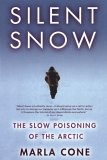Summary | Excerpt | Reviews | Beyond the Book | Readalikes | Genres & Themes | Author Bio

Critics' Opinion:
Readers' Opinion:
First Published:
Apr 2005, 256 pages
Paperback:
Apr 2006, 256 pages
 Book Reviewed by:
Book Reviewed by:
BookBrowse Review Team
Buy This Book
A few decades ago, the solution to pollution was dilution—scientists thought
that compounds dumped into the vast waters of the oceans would be out of the way
and rendered harmless. What they didn't understand was the underlying biology of
the sea—that chemicals have a far greater potential to accumulate in ocean life
than in land-dwelling creatures. Author and biologist Rachel Carson, in her
1962 classic Silent Spring, warned of the "sinister" nature of chemicals
that are passed from one organism to another. She knew that DDT sprayed on
alfalfa wound up in the livestock that ate it, and ultimately in the people who
ate the livestock. But ecosystems on land are simple—a cow eats grass, people
eat the cow. In contrast, the Arctic Ocean has a long and complex food web, with
so many layers that toxic compounds build up to extraordinarily high
concentrations.
Every human being, no matter where on Earth, contains traces of these toxic
compounds because of the chemicals' ability to persist in the environment and
magnify in the foods everyone eats, particularly seafood. But Arctic people are
especially vulnerable because of their place at the very top of the natural
world's dietary hierarchy. They eat 194 different species of wild animals, most
of them inhabiting the sea. Often on a daily basis, they consume the meat or
blubber (muktuk, mattak, or maktak in Arctic languages) of
fish-eating whales, seals, and walrus four or five links up marine food chains.
In contrast, many urban dwellers have lifestyles that distance them from their
polluted environment. Most have abandoned a hunting culture for agriculture,
eating much lower on the food web with a diet of mostly land-raised vegetables,
grains, beef, and poultry that contain less contaminants.
PCBs aren't the only hitchhikers determined to settle in the Arctic. Like PCBs,
the chlorinated pesticide DDT was first synthesized in the 1800s, although it
wasn't used as an insecticide until the 1940s, after Swiss scientist Paul
Hermann Müller noticed its ability to kill pests. Müller's discovery was
considered so miraculous that he later won a Nobel Prize for medicine. But DDT
began building up in the environment worldwide, wiping out birds and other
creatures. By the early 1970s, its use was banned in North America and Europe.
Still used in some countries to fight malaria and stockpiled in others, it is
still spreading globally, reaching the Arctic by the same atmospheric and
oceanic pathways as PCBs.
Today, about two hundred toxic pesticides and industrial compounds have been
detected in the bodies of the Arctic's indigenous people and animals, including
all twelve of the "Dirty Dozen," the so-called "legacy" organic pollutants such
as PCBs, DDT, mirex, dieldrin, and chlordane that are capable of inflicting the
most ecological damage. They are joined by mercury, a potent neurotoxin released
by coal-burning power plants and chemical factories. Mercury is on the rise in
many animals of the Arctic, and so are a variety of new contaminants such as
brominated flame retardants, widely applied to plastics and foam, and
perfluorinated acids, formerly used in Scotchgard and still used in making
Teflon. Unlike PCBs, DDT and brominated flame retardants, which accumulate in
fat, mercury and perfluorinated chemicals build up in protein-based tissues such
as the liver.
Because these synthetic marvels can survive virtually anything they encounter on
their global voyages, they are gradually building up in the remote reaches of
the far North to levels that jeopardize people, wildlife, and cultures that have
survived this harsh environment for millennia. The Arctic's people and animals
have been transformed into living, deep-freeze archives storing toxic memories
of the industrial world's past and present. This phenomenon is so insidious that
no one tapped into it for decades, until one day thirty-two years ago when
scientists stumbled on silent messengers that came in the form of plump Canadian
seals.
Copyright © 2005 by Marla Cone. Reprinted with permission from Grove Atlantic, Inc. All rights reserved.





The House on Biscayne Bay
by Chanel Cleeton
As death stalks a gothic mansion in Miami, the lives of two women intertwine as the past and present collide.

The Flower Sisters
by Michelle Collins Anderson
From the new Fannie Flagg of the Ozarks, a richly-woven story of family, forgiveness, and reinvention.

The Funeral Cryer by Wenyan Lu
Debut novelist Wenyan Lu brings us this witty yet profound story about one woman's midlife reawakening in contemporary rural China.
Your guide toexceptional books
BookBrowse seeks out and recommends the best in contemporary fiction and nonfiction—books that not only engage and entertain but also deepen our understanding of ourselves and the world around us.